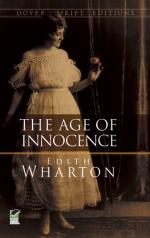Mrs. Archer and her son and daughter, like every one else in New York, knew who these privileged beings were: the Dagonets of Washington Square, who came of an old English county family allied with the Pitts and Foxes; the Lannings, who had intermarried with the descendants of Count de Grasse, and the van der Luydens, direct descendants of the first Dutch governor of Manhattan, and related by pre-revolutionary marriages to several members of the French and British aristocracy.
The Lannings survived only in the person of two very old but lively Miss Lannings, who lived cheerfully and reminiscently among family portraits and Chippendale; the Dagonets were a considerable clan, allied to the best names in Baltimore and Philadelphia; but the van der Luydens, who stood above all of them, had faded into a kind of super-terrestrial twilight, from which only two figures impressively emerged; those of Mr. and Mrs. Henry van der Luyden.
Mrs. Henry van der Luyden had been Louisa Dagonet, and her mother had been the granddaughter of Colonel du Lac, of an old Channel Island family, who had fought under Cornwallis and had settled in Maryland, after the war, with his bride, Lady Angelica Trevenna, fifth daughter of the Earl of St. Austrey. The tie between the Dagonets, the du Lacs of Maryland, and their aristocratic Cornish kinsfolk, the Trevennas, had always remained close and cordial. Mr. and Mrs. van der Luyden had more than once paid long visits to the present head of the house of Trevenna, the Duke of St. Austrey, at his country-seat in Cornwall and at St. Austrey in Gloucestershire; and his Grace had frequently announced his intention of some day returning their visit (without the Duchess, who feared the Atlantic).
Mr. and Mrs. van der Luyden divided their time between Trevenna, their place in Maryland, and Skuytercliff, the great estate on the Hudson which had been one of the colonial grants of the Dutch government to the famous first Governor, and of which Mr. van der Luyden was still “Patroon.” Their large solemn house in Madison Avenue was seldom opened, and when they came to town they received in it only their most intimate friends.
“I wish you would go with me, Newland,” his mother said, suddenly pausing at the door of the Brown coupe. “Louisa is fond of you; and of course it’s on account of dear May that I’m taking this step—and also because, if we don’t all stand together, there’ll be no such thing as Society left.”
VII.
Mrs. Henry van der Luyden listened in silence to her cousin Mrs. Archer’s narrative.
It was all very well to tell yourself in advance that Mrs. van der Luyden was always silent, and that, though non-committal by nature and training, she was very kind to the people she really liked. Even personal experience of these facts was not always a protection from the chill that descended on one in the high-ceilinged white-walled Madison Avenue drawing-room, with the pale brocaded armchairs so obviously uncovered for the occasion, and the gauze still veiling the ormolu mantel ornaments and the beautiful old carved frame of Gainsborough’s “Lady Angelica du Lac.”




